Local Activities
Welcome to Jonesburg!
Our little town is a hidden gem for wine lovers and those seeking a slice of scenic, small-town charm. With its rich history, friendly community, and proximity to beautiful vineyards, Jonesburg is the perfect spot for a peaceful getaway.
Exploring
Shopping
Dining
Adventure Seekers
Places to Explore
Little Lost Creek Conservation Area
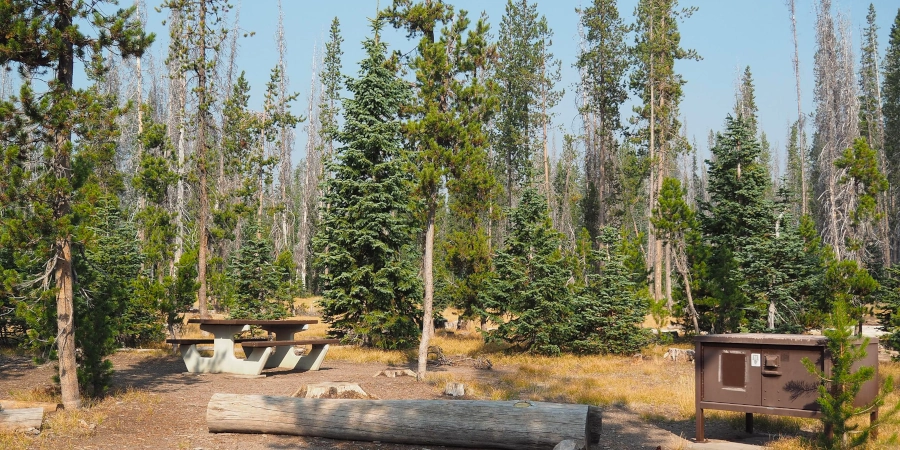 This is a partially spring-fed Ozark stream, characterized by clear water and a rocky stream bed. Brilliantly colored Ozark fish species such as bleeding shiners, southern red belly dace and stripped darters are found in the streams. The 2,899 acre area consists of mostly oak/hickory forest, woodlands and glades. A 5.2 mile hike through the area provides visitors with beautiful displays of foliage color.
This is a partially spring-fed Ozark stream, characterized by clear water and a rocky stream bed. Brilliantly colored Ozark fish species such as bleeding shiners, southern red belly dace and stripped darters are found in the streams. The 2,899 acre area consists of mostly oak/hickory forest, woodlands and glades. A 5.2 mile hike through the area provides visitors with beautiful displays of foliage color.
The Little Lost Creek Conservation Area is a haven for wildlife enthusiasts! You might encounter white-tailed deer gracefully moving through the forests, wild turkeys wandering around the glades, and playful squirrels darting among the trees. The area is also home to an impressive variety of bird species, including woodpeckers, owls, and songbirds—making it a great spot for birdwatching.
If you look closely near the streams and wetlands, you might spot frogs, turtles, and even the occasional mink. The diverse habitats support a thriving ecosystem, so there’s always something fascinating to observe.
Additionally, the Little Lost Creek Conservation Area offers a range of outdoor activities beyond wildlife observation. You can enjoy:
- Hiking
- Camping: Primitive camping is allowed in designated spots, letting you immerse yourself in nature overnight.
- Picnicking: Relax and enjoy a meal surrounded by the area’s tranquil landscapes.
- Fishing: Try your luck in the stream or ponds—there may be opportunities for anglers.
- Nature Photography: Capture the beauty of forests, glades, and wildlife.
- Star Gazing: With minimal light pollution, the conservation area is ideal for appreciating the night sky.
Below are features on the hiking loop:
- Trail Features: The loop includes scenic views of waterfalls, sandstone outcrops, and a spring-fed Ozark stream with clear water and a rocky bed.
- Wildlife and Flora: You’ll encounter diverse wildlife, including deer, turkeys, and songbirds, as well as beautiful oak and hickory forests.
- Elevation: The trail has an elevation gain of about 403 feet, making it a good workout without being overly strenuous.
- Activities: It’s popular for hiking, camping, and even horseback riding. Dogs are welcome but must be on a leash.
Best Time to Visit: The trail is especially stunning in the fall, with vibrant foliage, but it’s enjoyable year-round.
Katy Trail

Is built on the former corridor of the Missouri-Kansas-Texas Railroad (MKT or Katy), is 240 miles long and runs between Clinton and Machens with 26 trailheads and four fully restored railroad depots along the way. The section of trail between Cooper County and St. Charles County has been designated as an official segment of the Lewis and Clark National Historic Trail. Katy Trail is also part of the American Discovery Trail, has been designated as a Millennium Legacy Trail and was added to the Rails-to-Trails Conservancy Hall of Fame in 2008.
Trail users have the opportunity to wind through some of the most scenic areas of the state with the majority of the trail closely following the Missouri River. The park also takes users through a slice of rural history as it meanders through the small towns that once thrived along the railroad corridor and reflect the rich heritage of Missouri. Information at the trailheads makes a ride or walk on the Katy not only a healthy adventure, but also an educational one.
Klondike Park
 Located at 4600 Hwy. 94 South, Augusta, is a scenic property that includes more than four miles of natural surface and paved trails, a lake for fishing, kayaking and paddleboarding, a unique birding and wildlife area, shelters, playgrounds, and sites for cabin and tent camping.
Located at 4600 Hwy. 94 South, Augusta, is a scenic property that includes more than four miles of natural surface and paved trails, a lake for fishing, kayaking and paddleboarding, a unique birding and wildlife area, shelters, playgrounds, and sites for cabin and tent camping.
Here’s what you can enjoy:
- Hiking and Biking: The park offers over 5.5 miles of trails, including a bluff trail with stunning views of the Missouri River Valley. It also connects to the Katy Trail for extended adventures.
- Fishing and Water Activities: The park has a large quarry lake where you can fish or rent kayaks and paddleboards for exploring the water. Swimming is not allowed, but the white sand beach is perfect for relaxing.
- Camping: There are six camping cabins and 43 tent sites available for overnight stays. Seasonal showers and restrooms are provided.
- Wildlife and Birdwatching: The park is home to diverse wildlife and a designated birding area, making it ideal for nature enthusiasts.
- Picnicking and Playgrounds: Enjoy a meal at one of the picnic shelters or let kids have fun at the playgrounds.
Klondike Park offers several fantastic hiking trails that showcase its unique landscapes:
- Bluff Trail: This trail provides breathtaking views of the Missouri River Valley and is perfect for those seeking scenic vistas.
- Quarry Lake Trail: A loop around the park’s quarry lake, offering serene water views and opportunities for birdwatching.
- Connector Trail: Links Klondike Park to the Katy Trail, allowing for extended hiking adventures.
Klondike Park offers a variety of trails with different distances, difficulty levels and scenic references:
- Hogsback Trail: A 1.7-mile loop, rated as moderate. It features switchbacks and scenic views of the Missouri River. This route offers switchbacks and elevated views of the majestic Missouri River, making it a favorite for panoramic landscapes.
- Donkey Kong, Strip Mine, and Power Line Loop: Another 1.7-mile trail, also moderate, combining multiple trail systems for a diverse experience. Expect diverse terrain with views of the quarry lake and open meadows.
- Klondike Park Lake Loop: A short and easy 0.6-mile paved path around the lake, ideal for a leisurely stroll. The quarry lake is the star here, surrounded by striking white sand and unique natural beauty.
- Lewis and Clark Trail: A 2.6-mile easy trail with gravel paths and bridges, offering a peaceful hike. Peaceful gravel paths and wooden bridges provide charming and serene scenery.
- Klondike Overlook Trail: A 0.5-mile easy trail leading to a bluff with stunning views of the Missouri River.
Before you set out to hike the trails at Klondike Park, here are some tips to help you make the most of your adventure:
- Dress Appropriately: Wear sturdy, comfortable hiking shoes with good traction, especially for trails with switchbacks or uneven terrain. Layers are ideal for adjusting to changing weather.
- Bring Essentials: Carry plenty of water, snacks, sunscreen, and insect repellent. If you’re hiking a longer trail, consider packing a small first aid kit.
- Trail Maps: Familiarize yourself with the park’s trail map beforehand or bring one along, as it can be easy to lose track of smaller paths.
- Timing and Weather: Start early to avoid the midday heat and enjoy cooler temperatures. Be mindful of the weather forecast, as trails can become muddy after rain.
- Wildlife Awareness: Be respectful of wildlife and maintain a safe distance. Avoid leaving food or trash, as it can attract animals.
- Trail Etiquette: Stay on marked trails to protect the environment and prevent getting lost. Yield to others on narrow paths, especially bikers and horseback riders.
Daniel Boone Home
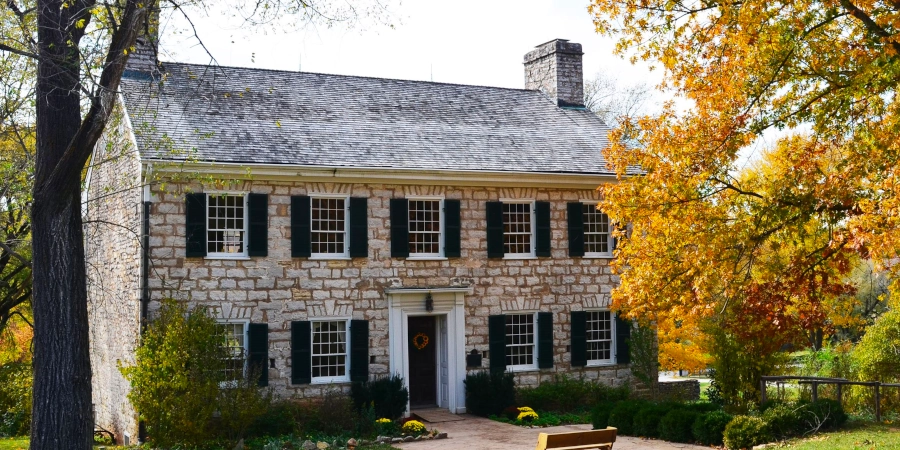
The Historic Daniel Boone Home site, located at 1868 Hwy. F, Defiance, features historic, reconstructed 19th century village and gift shop. The Park Department acquired the property in 2016 from Lindenwood University and officially renamed the park Lindenwood Park.
The Historic Daniel Boone Home, open year round, is a fascinating site that offers a glimpse into America’s frontier history. Here are some highlights:
- The Home: Built by Daniel Boone’s youngest son, Nathan Boone, the Georgian-style stone house was where Daniel Boone spent his later years. It’s now a museum showcasing artifacts and stories from the Boone family and Missouri’s territorial era.
- Boonesfield Village: Surrounding the home is a reconstructed 19th-century village with buildings like a general store, schoolhouse, and grist mill, giving visitors a feel for life on the Missouri frontier.
- Tours: Guided tours of the home and village are available, offering insights into pioneer life, Native American history, and more. Self-guided tours of the village grounds are free.
- Activities: The site hosts living history programs, artisan demonstrations, and seasonal events. It’s also a great spot for picnicking and exploring the scenic Femme Osage Valley.
Did you know? Daniel Boone was a legendary American frontiersman whose contributions were pivotal in shaping the early expansion of the United States:
- Exploration of Kentucky: Boone was instrumental in exploring and mapping the Kentucky region, paving the way for westward expansion.
- Blazing the Wilderness Road: He helped carve out the Wilderness Road through the Cumberland Gap, a critical route that allowed settlers to move westward into Kentucky and beyond.
- Founding of Boonesborough: Boone established one of the first permanent European-American settlements in Kentucky, which became a vital outpost for pioneers.
- Leadership in Frontier Conflicts: He played a key role in defending settlers during conflicts with Native American tribes, showcasing his bravery and leadership.
- Cultural Icon: Boone’s life and adventures inspired countless stories, making him a symbol of the American pioneering spirit.
What did Daniel Boone do for Americans? Daniel Boone’s legacy as a trailblazer and frontiersman inspired generations of American explorers and settlers. His contributions included:
- Pioneering Spirit: Boone’s exploration of Kentucky and the Wilderness Road demonstrated the possibilities of venturing into uncharted territories, encouraging others to follow in his footsteps.
- Mapping and Navigation: His ability to navigate and map new regions provided valuable knowledge for future explorers, making westward expansion more accessible.
- Cultural Icon
Indian Camp Creek Park
 2679 Dietrich Road, Foristell. 603 acres including more than 10 miles of multi-use trails for hiking, biking and equestrian use.
2679 Dietrich Road, Foristell. 603 acres including more than 10 miles of multi-use trails for hiking, biking and equestrian use.
Indian Camp Creek Park is the largest park in St. Charles County, spanning 603 acres. It offers a variety of activities and amenities:
- Trails for Hiking and Biking: Over 10 miles of multi-use trails for hiking, biking, and horseback riding.
- Fishing: A six-acre pond is stocked with bluegill, bass, and catfish, making it a great spot for anglers.
- Camping: Group camping sites are available for overnight stays.
- Disc Golf: An 18-hole disc golf course with rotating pin placements for enthusiasts.
- Playground: A large eco-playground with a water play area for kids.
- Observation Tower: A former silo turned into a tower for scenic views.
- Historic Sites: Preserved remains of a log cabin and the Cannon family cemetery from the 1800s.
Indian Camp Creek Park is open daily from sunrise to sunset, ensuring plenty of time to enjoy its trails and amenities. Parking is available at designated areas near the trailheads, playground, and other facilities. The park is well-equipped to accommodate visitors, making it easy to access your favorite spots.
New to disc golf? This course at Indian Camp Creek Park is a championship-caliber 18-hole course that offers a mix of challenges and scenic beauty. Here are some details:
- Course Layout: The course features a variety of terrains, including open fields, rolling hills, and a few wooded holes. It has two sets of tees and three pin placements on every hole, allowing for different levels of difficulty.
- Length: The course ranges from 4,732 feet to 8,782 feet, depending on the layout and pin placements.
- Obstacles: Many fairways are bordered by prairie grass, which serves as out-of-bounds (OB) areas, adding to the challenge. Some holes also incorporate water hazards.
- Tee Pads and Baskets: The course is equipped with concrete tee pads and Mach III baskets for a professional playing experience.
- Accessibility: The course is cart-friendly and suitable for players of various skill levels, though beginners might find the OB areas challenging.
Find Something New
Places to Shop & Sip



Hermann Wine Country
A historic town celebrated for its rich German heritage, vibrant wine culture, and welcoming community, nestled along the banks of the Missouri River.
The Wine Trail
Nestled in the scenic Missouri River Valley, this trail is celebrated for connecting some of the region’s most picturesque and award-winning wineries. This trail offers enthusiasts a unique opportunity to taste a wide variety of wines, from classic varietals to innovative blends, all while enjoying the stunning landscapes and friendly atmosphere that characterize Missouri wine country.
Learn More
The Town of Hermann
A charming and historic town that was rated by Travel + Leisure as one of Americas most beautiful small towns in the US. Enjoy a vibrant downtown area with quaint shops, delicious restaurants, and cozy bed and breakfasts, making it an enchanting destination for visitors seeking a blend of history, culture, and natural beauty.
Augusta
A picturesque small town nestled in the heart of Missouri’s wine country, renowned for its charming local shops, exceptional wineries and breweries, and inviting restaurants that offer a taste of local hospitality and flavors.
Local Shops
Wineries & Breweries
The region’s rich soil and favorable climate contribute to producing exceptional wines and beers. Visitors can enjoy tastings, tours, and breathtaking views, making Augusta a must-visit destination for connoisseurs and casual enthusiasts alike.
Learn More
Grab a Bite
Local chefs pride themselves on using fresh, regional ingredients to create mouthwatering dishes that cater to all tastes. Whether you’re in the mood for a casual meal or a fine dining experience, Augusta’s restaurants provide a warm and welcoming atmosphere.
Learn More
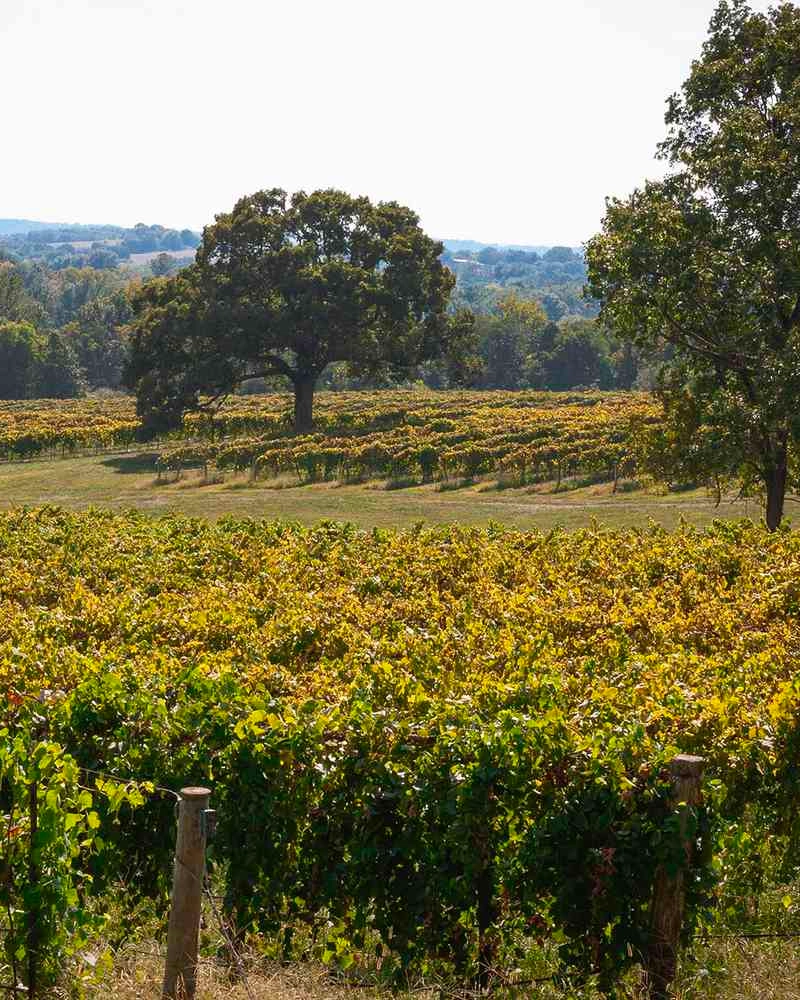
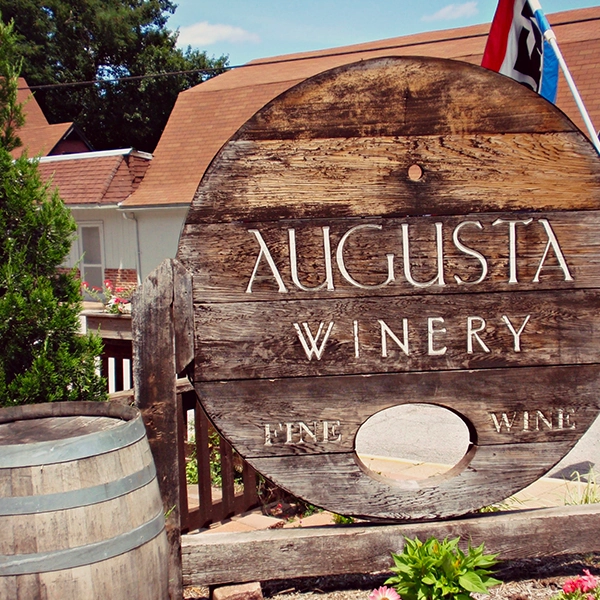
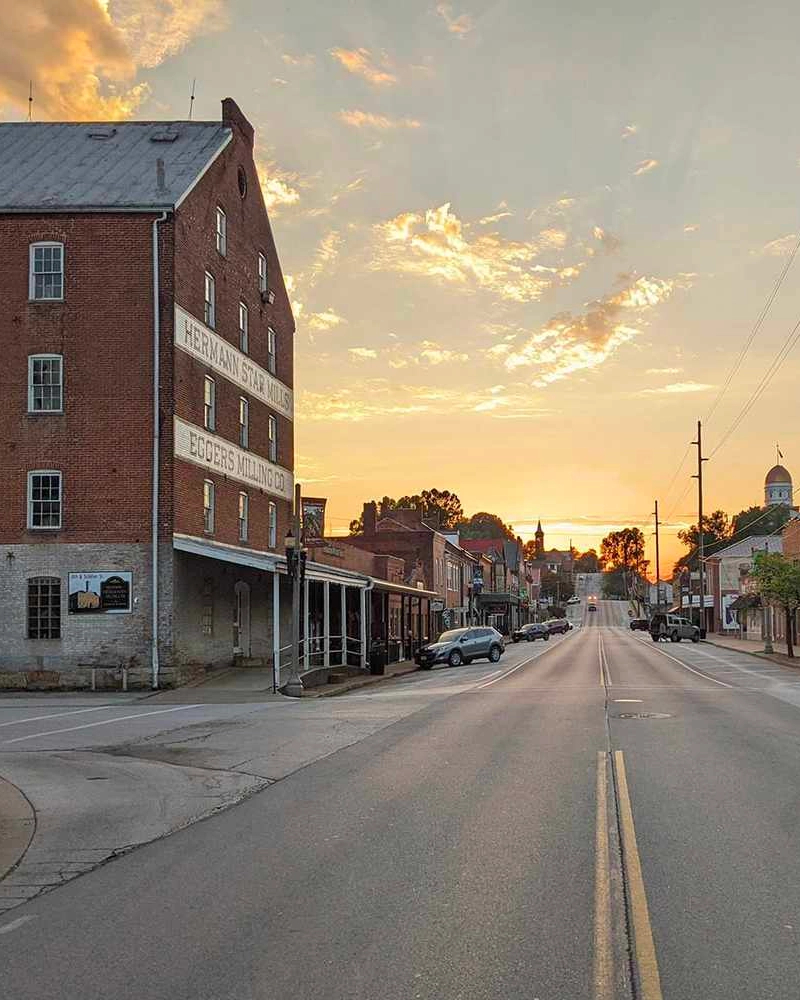



Augusta
A picturesque small town nestled in the heart of Missouri’s wine country, renowned for its charming local shops, exceptional wineries and breweries, and inviting restaurants that offer a taste of local hospitality and flavors.
Local Shops
Wineries & Breweries
The region’s rich soil and favorable climate contribute to producing exceptional wines and beers. Visitors can enjoy tastings, tours, and breathtaking views, making Augusta a must-visit destination for connoisseurs and casual enthusiasts alike.
Learn More
Grab a Bite
Local chefs pride themselves on using fresh, regional ingredients to create mouthwatering dishes that cater to all tastes. Whether you’re in the mood for a casual meal or a fine dining experience, Augusta’s restaurants provide a warm and welcoming atmosphere.
Learn More
Wineries We Recommend
Hermannhof Winery
300 E. 1st Street
Hermann, MO
Open 10:00am – 5:00pm
Adam Puchta Winery
1947 Frene Creek
Hermann, MO
Open 10:00am – 5:00pm
Oak Glenn Winery
1104 Oak Glenn Place
Hermann, MO
Open 10:00am – 5:00pm (Fri-Sun Only)
Hermann Wine Trolly
E 1st St & Schiller St
Hermann, MO
Enjoy The Night
Places to Dine
Frumpy Joe’s
105 E. Booneslick Rd
Jonesburg, MO
Warehouse Bar & Grill
102 Cedar Street
Jonesburg, MO
Oliver’s
289 W Veterans Memorial Pkwy
Warrenton, MO 63383
The Creek Grill & Sports Bar
2000 Phoenix Center Drive
Washington, MO 63090
Dos Primos
2072 Village Ln
Hermann, MO 65041
Concert Hall & Barrel Tavern
206 E 1st St
Hermann, MO 65041
Stone Hill Winery
1110 Stone Hill Hwy
Hermann, MO
Hermann Wurst Haus
234 E. 1st Street
Hermann, MO
Welcome to your own adventure
Welcome to Jonesburg
More about our Town
Jonesburg, Missouri, is a small town with a rich history located in Montgomery County. Established in the early 19th century, Jonesburg was officially incorporated in 1858. The town was named after the Jones family, early settlers who played a significant role in its development. Situated along the historic Missouri-Kansas-Texas Railroad, Jonesburg grew as a vital railroad community, facilitating trade and travel in the region.
Over the years, Jonesburg has maintained its small-town charm while adapting to changes. It has served as a local hub for agriculture and commerce, supporting the surrounding rural communities. Despite its modest size, Jonesburg has contributed to the cultural and historical fabric of Montgomery County, reflecting the broader story of growth and resilience in rural America.
1829
James Jones, arrives via stagecoach and settles here. He rents a room at a widow’s farm three miles northeast of High Hill.
1837
James Duckworth built the first building – one-story house used as a saloon and trading post.
1857
The North Missouri Railroad is built and reaches about two miles east of town. It was known as the “Y” lane road because of the shape of the tracks where engines could turn around. This station was used to haul wood to St. Louis. Henry Godfrey opens a blacksmith shop and later a livery stable in what will later become the Historical Society Building.
1910
Jonesburg gets its first telephones, and its first dental practice. Its population is now 456.
1916
The first light plant is established by Jim Shelton, making electricity broadly
available to the town for the first time. Shelton retained ownership of the company until selling it to the Missouri Edison Company in the 1920s.
1920
Jonesburg’s population reaches 473.
1922
The school expands to offer a four-year high school program.
1924
The center block of businesses in town catches fire, and townspeople are able to put the fire out by getting water from the road water line near Highway 40, which was in the process of being built.
1961
The city gets a second, larger fire truck, paid for by the rural fire protection
association.
1980
Jonesburg’s population grows to 614. The city encompasses 1.17 square miles.
2016
CertainTeed Roofing opens a new $100 million facility in Jonesburg, bringing with it nearly 100 new jobs.
Today
Jonesburg is a popular stop for travelers along I-70 and is loved by more than 720 residents who call it home.

